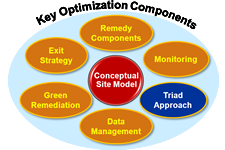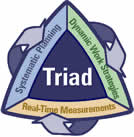Overview
Key Optimization Components: Triad Approach
 The Triad Approach is used during site characterization and remediation to manage decision uncertainty. It enables team members to make project decisions regarding contaminant presence, location, fate, exposure and risk reduction, and design correctly and cost-effectively. There are three elements of the Triad Approach: systematic project planning (SPP), dynamic work strategies (DWS) and use of real-time measurement technologies.
The Triad Approach is used during site characterization and remediation to manage decision uncertainty. It enables team members to make project decisions regarding contaminant presence, location, fate, exposure and risk reduction, and design correctly and cost-effectively. There are three elements of the Triad Approach: systematic project planning (SPP), dynamic work strategies (DWS) and use of real-time measurement technologies.
- SPP: A process for building a consensus vision for conducting environmental investigation and remediation. SPP activities include assembling stakeholders and creating a core technical team; developing a baseline conceptual site model (CSM); developing DWS elements to eliminate data gaps and test the CSM; and planning for real-time data management, assessment, visualization and communication.
- DWS: A work strategy that incorporates the flexibility to adapt to information generated by real-time measurement technologies. DWS typically use streamlined work plans with decision logic diagrams; sequences activities based on decisions to be made and a continuously updated CSM; generates collaborative data sets for multiple lines of evidence and controls uncertainties; provides real-time data management and communication; and considers potential remedies and reuse.
- Real-time measurement technologies: Data collected using real-time measurement technologies provides a greater density of measurements, can be used in a collaborative manner with other data sets to further support findings, employs strict field quality assurance/quality control to maximize data usefulness and can be used to target confirmatory sample locations. Real-time means a time frame that allows the project team to react to the information while still in the field.
One of the primary goals of the Triad Approach is to ensure that an effective CSM is developed and used for site decision-making throughout the life cycle of a cleanup project. The goals of the Triad Approach are in alignment with optimization because Triad's goals also support ensuring protective and cost-effective remedial strategies.
Selected Resources
Click on a column heading to sort the table. Search for additional publications or resources by keyword or topic using the Search page.
| Title | Document Number | Type | Date | |
|---|---|---|---|---|
| Demonstrations of Method Applicability under a Triad Approach for Site Assessment and Cleanup - Technology Bulletin August 2008 | EPA 542-F-08-006 | Factsheet | 2008 | |
| Triad Resource Center Website - Triad Case Studies | N/A | Online Resources | ||
| Best Management Practices: Use of Systematic Project Planning Under a Triad Approach for Site Assessment and Cleanup | EPA 542-F-10-010 | Technical Publication | 2010 | |
| Management and Interpretation of Data Under a Triad Approach - Technology Bulletin May 2007 | EPA 542-F-07-001 | Technical Publication | 2007 | |
| Use of Dynamic Work Strategies Under a Triad Approach for Site Assessment and Cleanup - Technology Bulletin | EPA 542-F-05-008 | Technical Publication | 2005 |






